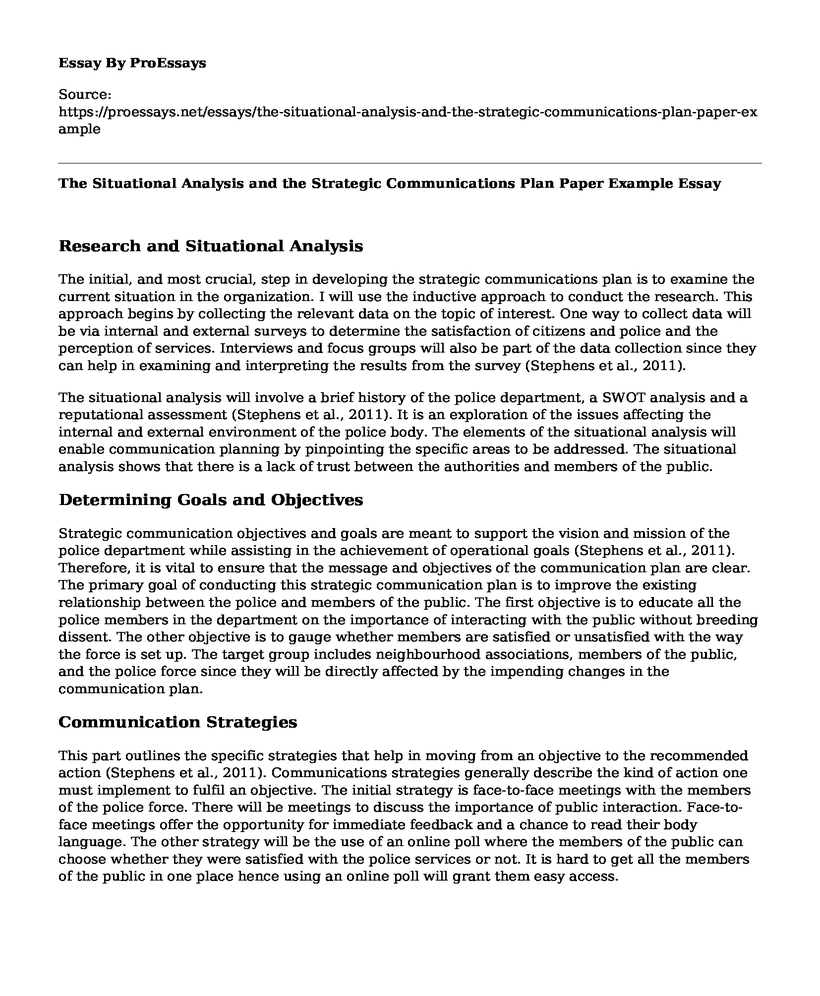Research and Situational Analysis
The initial, and most crucial, step in developing the strategic communications plan is to examine the current situation in the organization. I will use the inductive approach to conduct the research. This approach begins by collecting the relevant data on the topic of interest. One way to collect data will be via internal and external surveys to determine the satisfaction of citizens and police and the perception of services. Interviews and focus groups will also be part of the data collection since they can help in examining and interpreting the results from the survey (Stephens et al., 2011).
The situational analysis will involve a brief history of the police department, a SWOT analysis and a reputational assessment (Stephens et al., 2011). It is an exploration of the issues affecting the internal and external environment of the police body. The elements of the situational analysis will enable communication planning by pinpointing the specific areas to be addressed. The situational analysis shows that there is a lack of trust between the authorities and members of the public.
Determining Goals and Objectives
Strategic communication objectives and goals are meant to support the vision and mission of the police department while assisting in the achievement of operational goals (Stephens et al., 2011). Therefore, it is vital to ensure that the message and objectives of the communication plan are clear. The primary goal of conducting this strategic communication plan is to improve the existing relationship between the police and members of the public. The first objective is to educate all the police members in the department on the importance of interacting with the public without breeding dissent. The other objective is to gauge whether members are satisfied or unsatisfied with the way the force is set up. The target group includes neighbourhood associations, members of the public, and the police force since they will be directly affected by the impending changes in the communication plan.
Communication Strategies
This part outlines the specific strategies that help in moving from an objective to the recommended action (Stephens et al., 2011). Communications strategies generally describe the kind of action one must implement to fulfil an objective. The initial strategy is face-to-face meetings with the members of the police force. There will be meetings to discuss the importance of public interaction. Face-to-face meetings offer the opportunity for immediate feedback and a chance to read their body language. The other strategy will be the use of an online poll where the members of the public can choose whether they were satisfied with the police services or not. It is hard to get all the members of the public in one place hence using an online poll will grant them easy access.
The First 4 Main Steps
Research and situational analysis
I will research to identify whether there is a need for revising the communications plan. I will then conduct a situational analysis to see the various external and internal issues currently facing the department and determine the one that needs to be addressed. Research has shown that the current relations between the police and the public are at an all-time low.
Strategic Approach
The overall strategic approach shows the goals, objectives, and the strategies involved in achieving them (Potter, 2012).
Goal
The goal is to improve the relationship between the police force and the public.
Objectives
To educate all the police officers in the department regarding the importance of public relations. It will occur via face-to-face communication
To estimate whether the public is satisfied, or not, with the police service. It will be conducted via an online poll for the public.
Budget
The money needed to cover the education of police and conducting the research. The plan cannot proceed if there is no budget to perform these vital activities. I will calculate the real cost of achieving every objective to determine an accurate budget (Potter, 2012).
Evaluation
This step involves evaluating and measuring the results to determine whether the relationship between the public and police has improved.
References
Potter, L. (2012). The Strategic Communication Plan: An overview. Retrieved from https://www.iabc.com/the-strategic-communication-plan/
Stephens, D., Hill, J., & Greenberg, S. (2011). Strategic communication practices. Washington, D.C.: U.S. Department of Justice, Office of Community Oriented Policing Services.
Cite this page
The Situational Analysis and the Strategic Communications Plan Paper Example. (2022, Aug 23). Retrieved from https://proessays.net/essays/the-situational-analysis-and-the-strategic-communications-plan-paper-example
If you are the original author of this essay and no longer wish to have it published on the ProEssays website, please click below to request its removal:
- Importance of Good Leadership and Management Essay
- Essay on Calhoun's "Positive Good" Speech
- Paper Example on Moroccan New Labor Codes
- Career Center Career Opportunities in the Nursing Profession Essay
- How Parents Can Promote Good Reading Habits in Their Children Essay
- Developing an Employee Suggestion Program in Health Care Paper Example
- Essay Example on Conflict in Organizations: Types, Causes, Effects and How to Address







